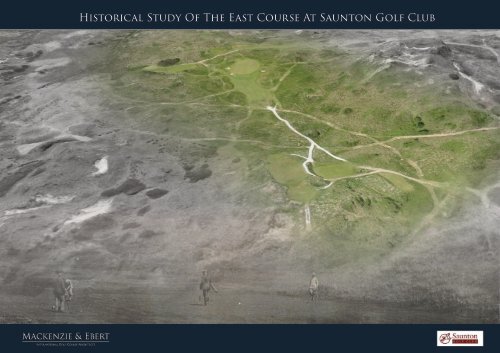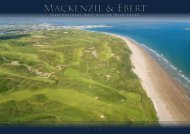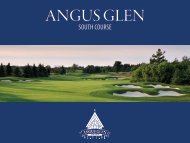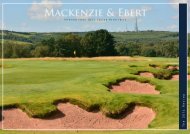You also want an ePaper? Increase the reach of your titles
YUMPU automatically turns print PDFs into web optimized ePapers that Google loves.
<strong>Historic</strong>al Study Of The East Course At <strong>Saunton</strong> Golf Club
Young caddy watches on as one of the Pitts Tucker<br />
founders plays his shot<br />
References:<br />
Richard Bass - 1996, Guide to the US Assault Training Centre North Devon (Un-published).<br />
http://www.assaulttrainingcenter.com/<br />
The History of <strong>Saunton</strong> Golf Club 1897 -1987<br />
<strong>Saunton</strong> Golf Club 1897-1997
Timeline<br />
1929 Clubhouse Opening Exhibition Match,<br />
James Braid putting on the pre-war 2nd green<br />
<strong>Saunton</strong> Golf Club first formed<br />
Thomas Dunn 9 holes<br />
Clubhouse opened<br />
9 Holes extended to 12 holes<br />
12 Holes extended to 18 holes<br />
4 Holes rearranged<br />
WWI Outbreak - Course reduced to 12 holes due to lack of labour<br />
Exhibition match between Harry Vardon & J.H. Taylor<br />
Resumption of club - W.H. Fowler engaged to re-design the course<br />
Moving into the natural dune land - The same layout as today apart<br />
from the 1st, 2nd, 17th & 18th holes<br />
New club house built in location recommended by W.H. Fowler<br />
celebrated with exhibition match between J.H.Taylor , James Braid,<br />
Henry Cotton & Bradbeer (<strong>Saunton</strong> Pro)<br />
Second 18 holes commissioned W.H. Fowler to design & build<br />
WWII Outbreak - Clubhouse requisitioned<br />
Ken Cotton invited to restore the Old Course - 13 holes almost put<br />
back as they were with a few minor changes but altered the 1st,2nd,<br />
6th, 17th & 18th holes<br />
Course reopened<br />
Frank Pennink engaged to design the West Course<br />
9 Holes open on the West course<br />
Full 18 holes open on the West Course<br />
POW from Normandy tasked with clearing the war debris<br />
US Assault Training Centre created by US Engineers and used by the<br />
US 146th Engineer Combat Battalion in preparation for D-Day<br />
The Committee decide to move the 1st Green on the East Course left<br />
as original position deemed too close to the 17th West fairway and<br />
could be dangerous<br />
Practice ground created<br />
1st Green East Course moved back towards original location - 2nd<br />
green East moved back and right<br />
Donald Steel engaged to redesign the 2nd fairway on the West Course<br />
Donald Steel engaged to rebuild all 18 greens on the West Course -<br />
Irrigation added to all tees and greens and 7th, 11th, 12th , 16th &<br />
18th fairways on the East Course<br />
1897<br />
1906<br />
19<strong>07</strong><br />
1908<br />
1912<br />
1914<br />
1919<br />
1923<br />
1929<br />
1935<br />
1939<br />
1943<br />
1944<br />
1950<br />
1952<br />
1972<br />
1974<br />
1975<br />
1975<br />
1979<br />
1980<br />
1987<br />
1992
Thomas Dunn<br />
Born Blackheath, England, 29th December 1849. Died Blagdon 1902 , aged 52.<br />
Tom Dunn became a professional at Wimbeldon Common (London Scottish) in 1870. The<br />
course had originally been laid out by his father , Old Willie Dunn, with 18 holes, but over<br />
the years it had been reduced to 7. In his first year at the club, Tom extended it to 18. He went<br />
on to hold professional positions at North Berwick, Tooting Beck, Meyrick Park amongst<br />
others.<br />
Dunn had four top-10 finishes in The Open Championship his best effort coming 6th in<br />
1869.<br />
He was the most prolific golf course architect of his day. He produced layouts that were<br />
inexpensive and serviceable, making it possible for increasing numbers of all social classes<br />
to take up the sport.<br />
He was a great salesman and is quoted as telling his clients; “God meant this site to be a golf<br />
course.” The first designer to work on inland courses rather than links he was a firm believer<br />
in a cross bunker requiring a forced carry from the tee, another for the approach and even a<br />
third on a three shot hole.<br />
Dunn himself considered Broadstone to be one of his greatest achievements where he was<br />
“not stinted for men, money or materials”. He felt Meryick Park the greatest challenge because<br />
of the densley covered heather, gorse and pine forest terrain.<br />
Tom was married to Isabel Gourlay, “the greatest women golfer of her day”. Tom travelled<br />
to America on several occasions visiting his brother Willie Dunn Jnr. (who also went on to<br />
become an architect). Despite his visits to the US, it is doubtful that he ever laid out a course<br />
there. While many American courses claim<br />
to have a Tom Dunn course, it is more<br />
likely they were laid out by one of the other<br />
Dunns.<br />
Tom’s work in Great Britain and on the<br />
Continent was extensive with more than<br />
137 courses.<br />
This timeline has been constructed<br />
using information from various<br />
sources, such as club histories, club<br />
websites, “The Architects of Golf ” by<br />
Cornish and Whitten.<br />
Born 1849<br />
Ashley Wood, Dorset - 9 holes 1893<br />
London Scottish Golf Club - Added 9 holes 1870<br />
Bath 1880<br />
Bramshaw - Manor Course 1880<br />
Felixstowe Ferry - 9 holes 1880<br />
Kinsdown 1880<br />
Cork - Ireland 1880<br />
Northe Berwick- Remodel 1883<br />
Brighton & Hove - 9 holes 1887<br />
Seaford 1887<br />
Dinard, France 1887<br />
Coubert - France 1888<br />
Blairgowrie 1889<br />
Bromley: Bude & North Cornwall GC 1890<br />
Eltham Warren 1890<br />
Tooting Bec 1890<br />
Ganton 1891<br />
Huddersfield 1891<br />
Lindrick 1891<br />
Northwood 1891<br />
Richmond 1891<br />
Royal Cinque Ports - 9 holes 1892<br />
Royal Mid Surrey 1892<br />
Royal Worlingon & Newmarket - 9 holes 1892<br />
Seacroft 1892<br />
Ventnor - 9 holes 1892<br />
Weston-Super-Mare 1892<br />
Enfield 1893<br />
Hastings & St. Leonards 1893<br />
Hastings 1893<br />
Royston 1893<br />
Woking 1893<br />
Haagsche - Netherlands 1893<br />
Buscott Park & Chiselhurst GC 1894<br />
Hampstead - 9 holes 1894<br />
Lansdown 1894<br />
Meyrick Park 1894<br />
Surbiton 1895<br />
Frinton 1896<br />
<strong>Saunton</strong> 1897<br />
Broadstone 1898<br />
Maidenhead 1898<br />
London Scottish Golf Club - Remodel 1901<br />
Bulwell Forest 1902<br />
Sheringham; Sherwood Forest - 9 holes 1904<br />
Erewash Valley 1905<br />
Beckenham Place Park 19<strong>07</strong><br />
Burhill - 9 holes 19<strong>07</strong><br />
North Oxford 1908<br />
Nottingham City 1908<br />
Whickham 1911<br />
Ralara - Canary Islands<br />
Unknown<br />
Littlestone - Remodel<br />
Unknown<br />
Died 1902
William Herbert Fowler<br />
Born Edmonton, England, 28th May 1856. Died London 13th April<br />
1941, aged 85<br />
Arthur Croome, one of Fowler’s design partners once write that:<br />
“Mr W. Herbert Fowler is a true aristocrat if ever there was one...Had<br />
he lived in Paris at the time of the revolution the mob would certainly<br />
have searched the city for a lantern high and strong enough to finish him<br />
off. The marks of your true aristocrat are a firm belief that the best dog<br />
must come out on top eventually, an instinct for discovering the best of<br />
everything and an unshakeable conviction that what he selects as the best<br />
is the best... You will very soon find that his real contempt is reserved for<br />
what is second-rate, ignorant or ignoble. That is why he has so seldom<br />
been proved wrong about golf, though he has given utterance in the most<br />
unequivocal terms to more categorical statements than most people.’<br />
This short quotation says a great deal about the man. He was born into a<br />
wealthy family and matured into a fine sportsman. He concentrated on<br />
cricket and played county cricket and for the MCC before discovering<br />
golf at the relatively old age of 23. Within a decade, he had achieved a<br />
handicap of scratch and was competing in The Amateur where he made<br />
the quarter finals before being soundly thrashed by Harold Hilton and<br />
in The Open where he tied for 26th in 1900. This rapid rise demonstrates<br />
just what an able sportsman he was. He was a large man, measuring a<br />
strong 6’3”.<br />
Around the turn of the century, his brother-in-law, Sir Cosmo Bonsor,<br />
approached him about a possible project south of London which was<br />
later to become Walton Heath, the course that launched his career<br />
as a golf course architect in 19<strong>07</strong>. By 1913, he had teamed up with<br />
Tom Simpson forming one of the great partnerships in golf course<br />
architecture that lasted until the late 1920s when Fowler was in his 70s.<br />
They worked across Europe and Fowler made several trips to the USA,<br />
designing Eastward Ho! (named after his beloved Westward Ho!) and<br />
Los Angeles Country Club as well as re-designing courses including<br />
creating the 18th hole at Pebble Beach.<br />
Both he and Simpson (pictured in the cartoon to the left) were highly<br />
intelligent and controversial figures. Fowler did not write all that much<br />
about architecture but Simpson certainly did, contributing regularly<br />
to Country Life, Golf Monthly and being featured in numerous other<br />
periodicals. He also co-authored with Joyce and Roger Wethered’s<br />
father one of the great books on golf course architecture called<br />
“The Architectural Side of Golf ”. His clear views were most probably<br />
formulated in discussions with Fowler.<br />
Despite Fowler’s background, his life was dogged by financial difficulties<br />
and it would appear that he was not great at managing money. In 1902,<br />
he was on the brink of bankruptcy when he was forced to sell his estate<br />
in Devon, moving close to London to find gainful employment in the<br />
form of designing Walton Heath. By 1912, things had turned for the<br />
good and he moved into a purpose built house near Walton Heath<br />
designed by Sir Edwin Lutyens. But late in his life, however, his troubles<br />
returned and in 1928 he was declared bankrupt, living out the rest of<br />
his life in accommodation and full board provided by Walton Heath<br />
Golf Club.<br />
“He will plant a difficulty just the least bit nearer<br />
to the hole than any other architect, for the shot is<br />
nearly good, he has little mercy.”<br />
Horace Hutchison<br />
The magnificent 1935 portrait of Fowler by Sir James Gunn RA
William Herbert Fowler Timeline<br />
Born 1856<br />
Cricket (Essex, Somerset and MCC)<br />
Started golf 1879<br />
Joined The R&A 1894<br />
Down to Scratch 1889<br />
Tied for 26th in The Open 1900<br />
To last 16 of The Amateur Championship, losing to Harold Hilton in his prime 1901<br />
Heavily indebted, sells up his house in Devon and moved close to Walton Heath. 1902<br />
Joined The R&A Green Committee 1902<br />
Walton Heath Old Course designed 1902<br />
Walton Heath Old Course opened 1904<br />
Walton Heath New Course designed 19<strong>07</strong><br />
Westward Ho! re-opened after major work by Fowler 1908<br />
Fountainbleu, France 1910<br />
Delamere Forest - original layout 1910<br />
West Surrey, Surrey 1910<br />
Simpson joined Fowler 1910<br />
LA Country Club (initial consultation) 1911<br />
Moved into “Chussex” a house designed in classical style by Edwin Lutyens and with a garden by Gertrude Jekyll close to WHGC 1912<br />
Beau Desert, Staffs 1912<br />
North Foreland, Kent Main 18 1912<br />
Woodcote Park, Surrey (CW) 1912<br />
Walton Heath New Course opened 1913<br />
Bull Bay, Wales (Club website) 1913<br />
Bickley Park Estate, Chislehurst, Kent 1914<br />
Shirley Park, Croydon Surrey 1914<br />
Dieppe, France 1914<br />
Spent much of WWI in the USA 1914- 1918<br />
West Kent, Kent 1916<br />
Yelverton, Devon (Club website) 1919<br />
<strong>Saunton</strong> East Course, Devon (Club Website) 1919<br />
Delamere Forest - revised layout 1920<br />
Fowler working on Eastward Ho! & Los Angeles Country Club 1920<br />
Fowler and Simpson set up an office in California 1920<br />
North Foreland, Kent Short Course 1920<br />
Fowler, Simpson, Abercromby and Croome formed 1921<br />
Eastward Ho! USA 1921<br />
Pebble Beach, California - extended 18th hole to its current design 1922<br />
Abbeydale, Yorkshire 1922<br />
Bradford, Yorkshire 1923<br />
Blackwell, Worcestershire 1923<br />
Crystal Springs, California 1924<br />
Knole Park, Kent 1924<br />
Cruden Bay, Scotland 1926<br />
Fowler, Simpson, Abercromby and Croome disbanded 1927<br />
Declared bankrupt 1928<br />
The Berkshire Red Blue opened 1928<br />
Manor House Hotel, Devon (now Bovey Castle) Mostly Abercromby? 1930<br />
<strong>Saunton</strong>, Devon 1935<br />
Died 1941<br />
“An erratic genius...<br />
perhaps the most daring<br />
and original of all golf<br />
course architects”<br />
Bernard Darwin<br />
This timeline has been constructed<br />
using information from various<br />
sources, such as club histories, club<br />
websites, “The Architects of Golf ”<br />
by Cornish and Whitten.
The Words of William Herbert Fowler<br />
“Bunkers should only act as hazards for wide shots.”<br />
“I think that a bunker should mean on average the loss of one<br />
stroke, .......the ball should always be in the bottom of the bunker,<br />
and not hard up against the face”<br />
“I have often thought that the importance of the hazards of<br />
a course is very much under-estimated by makers of courses,<br />
Green Committees, and players generally, and yet I think that<br />
good hazards are really almost the most important feature of a<br />
course. To my mind it is a near thing between the hazards and the<br />
greens as to which is more important to the making of a first class<br />
course.” (from Golf Greens and Greenkeeping, edited by Horace<br />
Hutchinson, 1911)<br />
“In my opinion, a course of from 6,300 to 6,500 yards is amply<br />
long enough, and the latter should not be exceeded. For all<br />
championships I think there should be specially laid-out courses,<br />
one in England and one in Scotland, and then one could have a<br />
course which would be long enough to test even the longest hitters.<br />
Some day, no doubt, this will be made, but until it arrives I do<br />
hope courses will be kept to a reasonable length.” (c1920 Lecture<br />
to Golf Greenkeepers’ Association)<br />
On Selecting a suitable Club Secretary, he advised Abbeydale<br />
Golf Club in Sheffield:<br />
“What you want is a man of character, who is capable, has good<br />
manners, and is patient with idiots.”<br />
“A great deal has been written of late years in favour of making<br />
holes of one, two and three full shots in length, as if this would<br />
make such holes interesting. Such theories are upset by the first<br />
strong wind that blows; but a hole which is properly guarded can<br />
be made interesting, and as difficult as desired, by the proper<br />
placing of hazards, no matter what its length may be.” (from Golf<br />
Greens and Greenkeeping, edited by Horace Hutchinson, 1911)<br />
“We want more cross bunkers in addition to the flanking ones<br />
to curtail the long drivers from getting nearer the green than a<br />
certain distance to play their approaches.” Golfing 1915<br />
“There is one test of a good slope from a bank. One should never be<br />
able to point to any spot where the slope ends. There is a lot more<br />
in this than one would at first imagine.” (c1920 Lecture to Golf<br />
Greenkeepers’ Association)<br />
“In laying out a course, great care should be taken to see that the<br />
one-shot holes are of the best possible quality. Personally, I think<br />
a course is never a good one unless this class of hole is really firstclass.<br />
Now that inventors have so spoilt the game by making it<br />
possible to hit the ball to impossible distances, the only thing a<br />
golf architect can do to get decent two shot holes is to increase the<br />
number of holes of the one-shot variety.”<br />
(c1920 Lecture to Golf Greenkeepers’ Association)
The Words of William Herbert Fowler<br />
This text is taken from a chapter that Fowler wrote in a book<br />
called “Golf Greens and Greenkeeping”, edited by Horace<br />
Hutchinson and published in 1911 a few years after Walton Heath<br />
Old Course opened and shortly after he and Simpson teamed<br />
up. They were both inspired by the work of John Low and Stuart<br />
Paton at Woking Golf Club, Simpson so much so that it prompted<br />
him to change career from law to golf course design.<br />
This early article by Fowler shows that at this stage his thinking<br />
was relatively under-developed and his thinking evolved over the<br />
years. Simpson was a great thinker and prolific writer about golf<br />
design and the two men must have spent hours debating topics as<br />
they were both outspoken characters.<br />
These quotations give a good impression of Fowler’s approach to<br />
design which is helpful. He did not write too much about the strategic<br />
approach that Horace Hutchison mentioned in his quote:<br />
“He will plant a difficulty just the least bit nearer to the hole<br />
than any other architect, for the shot is nearly good, he has<br />
little mercy.”<br />
It is interesting, though, that by 1922, the Fowler, Abercromby,<br />
Simpson and Croome brochure dedicated an entire page to the<br />
following clear statement:<br />
“It is true to say that at least 90% of those who play golf<br />
are firmly convinced that courses are planned<br />
for the benefit of the scratch player.<br />
One moment’s reflection should dispel the idea<br />
that courses are laid out for 1% of those who play golf.<br />
We are business men, and do not lay out courses<br />
for the benefit of our health,<br />
and if in fact we only consulted the interests of 1%<br />
we should soon cease to have a business,<br />
for no one would employ us or recommend us.”
<strong>Historic</strong> Club Photographs<br />
Note the open sand areas in this post war shot of the 18th designed by Ken Cotton around 1950
Drive from the then 1st Tee Before WWII<br />
<strong>Historic</strong> Club Photographs
11th Green<br />
Archive photograph - 8th August 1946
<strong>Historic</strong> Newspaper Articles<br />
“Golf.” Times [London, England] 12 June<br />
1925: Bernard Darwin<br />
“..one of the courses<br />
of the world”<br />
“..there is scarcely an<br />
artificially cut bunker”<br />
“Parliament.” Times [London, England] 10 Apr. 1913:<br />
Bernard Darwin
<strong>Historic</strong> Newspaper Articles<br />
“Golf.” Times [London, England] 9<br />
Nov 1935: Bernard Darwin<br />
“Golf.” Times [London, England] 8 Aug. 1929:<br />
Bernard Darwin<br />
“..What more<br />
can a golfer<br />
want?”
The Course Evolution
1st Course Layout 9 Holes - 1984 (As Remembered By Philip Harris)<br />
<strong>Saunton</strong>’s original 9 hole Course is credited to Thomas Dunn
2nd Course Layout 18 Hole (As Remembered By Philip Harris)
Course Layout - 1921 W. H. Fowler
Course Layout - 1935<br />
Hole Yards Par<br />
1 210 3<br />
2 380 4<br />
3 384 4<br />
4 460 5<br />
5 120 3<br />
6 400 5<br />
7 440 5<br />
8 375 4<br />
9 386 5<br />
Out 3155 38<br />
10 316 4<br />
11 360 4<br />
12 460 5<br />
13 140 3<br />
14 475 5<br />
15 480 5<br />
16 421 5<br />
17 170 3<br />
18 418 5<br />
In 3240 39<br />
Out 3155 38<br />
Total 6395 77
Course Layout - 1951 (C. K. Cotton)
Current Course Layout - 2016<br />
12<br />
11<br />
7<br />
13<br />
14<br />
6<br />
15<br />
10<br />
8<br />
16<br />
3<br />
9<br />
5<br />
17<br />
2<br />
4<br />
18<br />
1
World War II the Occupied Years
The US Assault Training Centre Occupied 1939 - 1951<br />
In 1943 work started on The Assault Training Centre based at <strong>Saunton</strong>. It was created due to an oversight at the<br />
highest levels of the American War Planning Office which had assumed that American troops sent to lead the<br />
spearhead assault into Europe would be trained for assault. This was not the case as most infantry divisions were<br />
‘green’ or inexperienced in combat and this had to be addressed urgently with the invasion planned only a few<br />
months ahead.<br />
At this time, the only published advice in the US Army Field Manual was “Fortified areas are to be avoided in<br />
the initial assault and then taken from the rear.” The plan to attack the Normandy coastal defences would require<br />
a head on beach assault using multi skilled teams or ‘Assault Sections’ including demolitions, rocket launchers,<br />
flame throwers and machine gunners.<br />
The ATC (Assault Training Centre) brief was to train these assaults sections under realistic conditions including<br />
overcoming on and off-shore obstacles, reduction of fortifications, repulsing of counter attacks and establishing of<br />
the beach head.<br />
The British and Canadians were well ahead with their training and had already claimed all suitable beaches except<br />
Woolacombe. Woolacombe had been deemed too stormy for amphibious landing craft by the British. Many<br />
natural features including the sand type, dune-scape and tides made Woolacombe an almost exact match for their<br />
destination ‘Omaha beach’ in Normandy. The ATC was divided into lettered areas along the coastline from A-M,<br />
<strong>Saunton</strong> being allocated ‘D’ containing the greatest concentration and variety of assault and training facilities.<br />
The 398th Engineer General Service arrived on 1st September 1943 and were given orders to build replicas of<br />
structures included a full-scale German-type ‘Hedgehog’ that the American troops were likely to encounter<br />
in Normandy. Once the initial construction had been carried out, the 146th Engineer Combat Battalion took<br />
charge in September 1943 of maintenance and rebuilding. American Troops were to visit the ATC for 3 weeks of<br />
training.<br />
After D-Day, the ATC was occupied by the 18th Field Force Replacement Depot to house and feed replacement<br />
troops on their way to Europe. It is certain that the training and research that took place at <strong>Saunton</strong> and all along<br />
the 16 mile stretch of coastline that was used by the ATC was vital to the success of D-Day. Colonel Paul W.<br />
Thompson, the then commandant said “If the battle of Waterloo was won on the playing fields of Eton, then the<br />
Assault Training Centre contributed in no small measure to the success of D-Day”.
The US Assault Training Centre Occupied 1939 - 1951<br />
Obstacle Course<br />
Concrete wall<br />
Target Pits<br />
Ships Sides<br />
Tank Trap<br />
Wire Cutting<br />
Anti-Aircraft<br />
Battery<br />
Clubhouse<br />
Troops billeted in<br />
Nissan huts<br />
Pillboxes<br />
LCVP-LCM Mock Up Area<br />
LCVP Landing Craft Vehicle Personnel<br />
LCM Landing Craft, Mechanized<br />
Flame Thrower Range<br />
‘Hedgehog’ Mock Up Area<br />
The hedgehog defence is a military tactic for defending against a<br />
mobile armoured attack, or blitzkrieg. The defenders deploy in<br />
depth in heavily fortified positions suitable for all-around defence.<br />
The attackers can penetrate between these “hedgehogs”, but each<br />
position continues to fight on when surrounded. This keeps large<br />
numbers of attacking troops tied up, attacking the well-defended<br />
strong-points, while allowing the defenders to successfully<br />
counter-attack against the units that bypass these strong-points<br />
with their own armoured reserves by cutting them off from their<br />
supporting elements.<br />
Dragon’s Teeth<br />
Mine & Booby<br />
Trap Area
<strong>Historic</strong> & Current Day Aerial Photography
<strong>Historic</strong> Aerial Photography<br />
Points of Interest<br />
1. The aerial photographs where taken by RAF 58 (1916 to 1976) & 540 (1942 to<br />
1956 ) photo-reconnaissance Squadrons of the Royal Air Force mainly operating<br />
Mosquitoes and Anson’s. Based at RAF Benson in South Oxfordshire, England.<br />
2. The aerial photography shows the essential part that <strong>Saunton</strong> played in the<br />
American preparations for World War II D-Day assault on the Normandy<br />
beaches. The first aerial from 1946, shows the extent of the destruction that took<br />
place during occupation by tanks, landing craft, demolition practice etc.<br />
3. The aerial photographs provide information regarding the evolution of green<br />
shapes and sizes, the number of bunkers, the bunker locations, bunker sizes,<br />
bunker shapes, open sand areas, fairway widths and the extent and nature of the<br />
vegetation.<br />
4. In terms of the greens, its seems as though a number of the greens may have<br />
survived the war. The actual green boundaries are hard to make out on the 1946<br />
aerial.<br />
5. Tees locations have been adjusted over the years as would be expected with the<br />
advances in ball and club technology. The centre lines shown on the hole by hole<br />
comparison plans are those of today to illustrate just how far tees have gone<br />
backwards and directions of play have been adjusted for some of the holes.<br />
6. The aerial photographs are interesting in what they reveal with respect to the<br />
bunkers. The 1946 aerial shows no man-made bunkers but there are vast blown<br />
out sand dunes/ craters, however, as well as a number of smaller size sand scrapes<br />
that look like they could have been bunkers from the pre-war course left by the<br />
Americans and maybe some of these were original features of Fowler’s Course.<br />
Certainly, the plan from 1935 shows the locations of ‘sand pits’ and bunkers.<br />
There is a significant change in sizes and shape of the bunkers between the 1957<br />
and the 1989 aerial, with the 1989 larger and distinctly more rounded shapes.<br />
The average size of the bunkers between 1989 and the current 2016 aerial have<br />
reduced but the number of bunker has increased from 38 to 56.<br />
7. The fairway widths look as though they were generous by comparison with those<br />
of today. This is a common finding in historical studies of courses.
Bunker Analysis<br />
Histotrical Bunker Count<br />
1935 Bunker count = 25 /12 open sand<br />
1957 Bunker count = 45/18 os<br />
1989 Bunker count = 38<br />
2016 Bunker count = 56
The Evolution Of The Course<br />
The 4th Hole<br />
Fairway widths<br />
Fairway widths have tended to reduce as it has become easier to hit the ball straighter and as new fairway<br />
mowers have been introduced.<br />
The 7th Hole<br />
Bunker Style<br />
There is little evidence of the early bunker style. The<br />
earliest plan showing bunkers is from 1935 and this<br />
shows a combination of man-made bunkers and ‘sand<br />
pits’. In 1925 Bernard Darwin wrote “..And though<br />
there is such a profligate wealth of trouble there is<br />
scarcely an artificially cut bunker on the course”. Over<br />
time, bunkers have become simpler in shape as has<br />
occurred on many links courses.<br />
5th July 1957<br />
5th July 1957 4th May 1989 Current Day
May 1946 RAF Aerial Photography<br />
12<br />
11<br />
7<br />
13<br />
14<br />
6<br />
15<br />
10<br />
8<br />
17<br />
16<br />
3<br />
9<br />
5<br />
18<br />
2<br />
4<br />
1
November 1952 RAF Aerial Photography<br />
12<br />
11<br />
7<br />
13<br />
14<br />
6<br />
15<br />
10<br />
8<br />
16<br />
3<br />
9<br />
5<br />
17<br />
2<br />
4<br />
18<br />
1
July 1957 RAF Aerial Photography<br />
12<br />
11<br />
7<br />
13<br />
14<br />
6<br />
15<br />
10<br />
8<br />
16<br />
3<br />
9<br />
5<br />
17<br />
2<br />
4<br />
18<br />
1
May 1989 RAF Aerial Photography<br />
12<br />
11<br />
7<br />
13<br />
14<br />
6<br />
15<br />
10<br />
8<br />
16<br />
3<br />
9<br />
5<br />
17<br />
2<br />
4<br />
18<br />
1
Current Day Aerial Photography<br />
12<br />
11<br />
7<br />
13<br />
14<br />
6<br />
15<br />
10<br />
8<br />
16<br />
3<br />
9<br />
5<br />
17<br />
2<br />
4<br />
18<br />
1
Hole By Hole Comparisons Of The<br />
1946, 1949, 1952, 1957, 1989 & Current Day Layouts
East Course - Hole 1 - 1946, 1952 & Current Day Aerial Photograph Comparison<br />
Current day centre line<br />
shown on all plans<br />
5th May 1946<br />
Major destruction to<br />
original Course<br />
24th November 1952<br />
Ken Cotton green location<br />
Current Day
East Course - Hole 1 - 1957, 1989 & Current Day Aerial Photograph Comparison<br />
Current day centre line<br />
shown on all plans<br />
Large blow out sand area<br />
5th July 1957<br />
Original green location<br />
All that remains of natural bunkers<br />
4th May 1989<br />
More rugged bunker shapes<br />
Left bunker has gone<br />
New bunkers<br />
Current Day
East Course - Hole 2 - 1946, 1952 & Current Day Aerial Photograph Comparison<br />
Current day centre line<br />
shown on all plans<br />
5th May 1946<br />
Original direction of play<br />
Mock up ships sides<br />
24th November 1952<br />
Current Day<br />
New green
Hole 2 - 1957, 1989 & Current Day Aerial Photograph Comparison<br />
Current day centre line<br />
shown on all plans<br />
5th July 1957<br />
Ken Cotton green location<br />
New green location<br />
4th May 1989<br />
Current Day
East Course - Hole 3 - 1946, 1952 & Current Day Aerial Photograph Comparison<br />
Current day centre line<br />
shown on all plans<br />
5th May 1946<br />
Large sand craters<br />
Blown out dune<br />
24th November 1952<br />
Current Day
East Course - Hole 3 - 1957, 1989 & Current Day Aerial Photograph Comparison<br />
Current day centre line<br />
shown on all plans<br />
5th July 1957<br />
4th May 1989<br />
Current Day
East Course - Hole 3 - 1957 Oblique View<br />
Green<br />
Tees<br />
2nd Hole
East Course - Hole 3 - Current Day Oblique View<br />
West 10th Hole<br />
West 9th Hole<br />
West 6th Hole<br />
West 5th Hole<br />
15th Hole<br />
2nd Hole
East Course - Hole 4 - 1946, 1952 & Current Day Aerial Photograph Comparison<br />
Current day centre line<br />
shown on all plans<br />
5th May 1946<br />
Blown out dunes<br />
Crater bunker<br />
24th November 1952<br />
Current Day
East Course - Hole 4 - 1957, 1989 & Current Day Aerial Photograph Comparison<br />
Current day centre line<br />
shown on all plans<br />
Remnant bunkers?<br />
Blown out dunes<br />
5th July 1957<br />
One left bunker<br />
4th May 1989<br />
One right bunker remains<br />
New right bunker<br />
4 bunkers<br />
Left bunker has returned<br />
Current Day
East Course - Hole 5 - 1946, 1952 & Current Day Aerial Photograph Comparison<br />
Current day centre line<br />
shown on all plans<br />
Original bunkers?<br />
5th May 1946<br />
24th November 1952<br />
Crater bunkers<br />
Current Day
East Course - Hole 5 - 1957, 1989 & Current Day Aerial Photograph Comparison<br />
Current day centre line<br />
shown on all plans<br />
Large sandy areas in carry<br />
Green extended<br />
5th July 1957<br />
Bunker off to the right<br />
4th May 1989<br />
Bunker filled<br />
Current Day
East Course - Hole 5 - 1957 Oblique View<br />
Tees<br />
Green
East Course - Hole 5 - Current Oblique View
East Course - Hole 6 - 1946, 1952 & Current Day Aerial Photograph Comparison<br />
Current day centre line<br />
shown on all plans<br />
5th May 1946<br />
No evidence of green<br />
24th November 1952<br />
Greens back<br />
Current Day
East Course - Hole 6 - 1957, 1989 & Current Day Aerial Photograph Comparison<br />
Current day centre line<br />
shown on all plans<br />
Open sand scrape<br />
5th July 1957<br />
4th May 1989<br />
Current Day
East Course - Hole 7 - 1946, 1952 & Current Day Aerial Photograph Comparison<br />
Current day centre line<br />
shown on all plans<br />
5th May 1946<br />
Three humps<br />
Bunkers made sense<br />
in bogey 5 hole<br />
24th November 1952<br />
Current Day
East Course - Hole 7 - 1957, 1989 & Current Day Aerial Photograph Comparison<br />
Current day centre line<br />
shown on all plans<br />
5th July 1957<br />
2 Bunkers<br />
The fairway was much wider and<br />
extended further back towards the tees<br />
Remains of old bunkers<br />
Green-side bunker enlarged<br />
4th May 1989<br />
Two bunkers merged into one<br />
Current Day<br />
This bunker is out of range<br />
from the tee and irrelevant of<br />
par 4<br />
Bunker moved
East Course - Hole 8 - 1946, 1952 & Current Day Aerial Photograph Comparison<br />
Current day centre line<br />
shown on all plans<br />
Concrete wall<br />
Blown out dune<br />
5th May 1946<br />
The characteristic amphitheatre<br />
8th green<br />
24th November 1952<br />
Blown out dune left after the<br />
demolition of the wall<br />
Current Day
East Course - Hole 8 - 1957, 1989 & Current Day Aerial Photograph Comparison<br />
Current day centre line<br />
shown on all plans<br />
5th July 1957<br />
4th May 1989<br />
Current Day
East Course - Hole 9 - 1946, 1952 & Current Day Aerial Photograph Comparison<br />
Current day centre line<br />
shown on all plans<br />
5th May 1946<br />
The flame thrower range<br />
24th November 1952<br />
Current Day
East Course - Hole 9 - 1957, 1989 & Current Day Aerial Photograph Comparison<br />
Current day centre line<br />
shown on all plans<br />
5th July 1957<br />
No drive bunkers<br />
Approach bunker added<br />
4th May 1989<br />
A ‘threesome’ on the green<br />
Green extended further right<br />
Approach bunker moved to<br />
green edge<br />
Current Day<br />
Drive bunkers added
East Course - Hole 10 - 1946, 1952 & Current Day Aerial Photograph Comparison<br />
Current day centre line<br />
shown on all plans<br />
5th May 1946<br />
24th November 1952<br />
Current foregreen is green<br />
Current Day
East Course - Hole 10 - 1957, 1989 & Current Day Aerial Photograph Comparison<br />
Current day centre line<br />
shown on all plans<br />
5th July 1957<br />
Green has reduced in size<br />
Large expanse of fairway for the<br />
landing area<br />
Two approach bunkers added<br />
4th May 1989<br />
These two approach bunkers<br />
have been enlarged<br />
The green surface was<br />
mown out to the bases of the<br />
surrounding mounds<br />
Current Day
East Course - Hole 11 - 1946, 1952 & Current Day Aerial Photograph Comparison<br />
Current day centre line<br />
shown on all plans<br />
5th May 1946<br />
Trenches?<br />
24th November 1952<br />
Current Day
East Course - Hole 11 - 1957, 1989 & Current Day Aerial Photograph Comparison<br />
Current day centre line<br />
shown on all plans<br />
The fairway was mown out to the left<br />
Greenside bunker in the hollow<br />
5th July 1957<br />
The 11th green was historically<br />
played from the opposite direction.<br />
The 5th hole on the 9 hole 1st course<br />
and the 4th hole on the 18 hole 2nd<br />
course. This accounts for the fall on<br />
the green.<br />
Two small bunkers<br />
Original direction of play<br />
4th May 1989<br />
Two small bunkers<br />
merged into one<br />
Current Day
East Course - Hole 12 - 1946, 1952 & Current Day Aerial Photograph Comparison<br />
Current day centre line<br />
shown on all plans<br />
Trenches<br />
5th May 1946<br />
24th November 1952<br />
Current Day
East Course - Hole 12 - 1957, 1989 & Current Day Aerial Photograph Comparison<br />
Current day centre line<br />
shown on all plans<br />
5th July 1957<br />
Single greenside bunker<br />
Left-hand greenside bunker added<br />
4th May 1989<br />
Current Day
East Course - Hole 13 - 1946, 1952 & Current Day Aerial Photograph Comparison<br />
Current day centre line<br />
shown on all plans<br />
5th May 1946<br />
Bunkers?<br />
Bunker at the rear of the green<br />
24th November 1952<br />
Bunkers<br />
Large sand crater<br />
Current Day
East Course - Hole 13 - 1957, 1989 & Current Day Aerial Photograph Comparison<br />
Current day centre line<br />
shown on all plans<br />
5th July 1957<br />
4th May 1989<br />
Current Day
East Course - Hole 14 - 1946, 1952 & Current Day Aerial Photograph Comparison<br />
Current day centre line<br />
shown on all plans<br />
5th May 1946<br />
The obstacle course<br />
Blown out sand dune<br />
Blown out sand dune<br />
24th November 1952<br />
Blown out sand dunes<br />
Current Day
East Course - Hole 14 - 1957, 1989 & Current Day Aerial Photograph Comparison<br />
Current day centre line<br />
shown on all plans<br />
Left hand bunker has appeared<br />
5th July 1957<br />
Single bunker<br />
Left hand bunker has gone again<br />
4th May 1989<br />
Old bunker<br />
2 bunkers<br />
Current Day<br />
Old bunker<br />
4 bunkers
East Course - Hole 15 - 1946, 1952 & Current Day Aerial Photograph Comparison<br />
Current day centre line<br />
shown on all plans<br />
5th May 1946<br />
Blown out sand dune<br />
Blown out sand dune<br />
24th November 1952<br />
No bunkers<br />
Current Day
East Course - Hole 15 - 1957, 1989 & Current Day Aerial Photograph Comparison<br />
Current day centre line<br />
shown on all plans<br />
5th July 1957<br />
Two bunkers set into the humps<br />
and hollows<br />
4th May 1989<br />
Current Day
East Course - Hole 16 - 1946, 1952 & Current Day Aerial Photograph Comparison<br />
Current day centre line<br />
shown on all plans<br />
Open sand crater<br />
Ships sides<br />
5th May 1946<br />
Pillboxes<br />
24th November 1952<br />
Blown out sand dunes<br />
Original 8th green<br />
location (9 hole layout)<br />
Current Day
East Course - Hole 16 - 1957, 1989 & Current Day Aerial Photograph Comparison<br />
Current day centre line<br />
shown on all plans<br />
5th July 1957<br />
Large rough edged bunker<br />
4th May 1989<br />
Approach bunker added<br />
Drive bunker reduced in size<br />
Current Day<br />
These bunker have<br />
since been moved
East Course - Hole 16 - 1957 Oblique View<br />
Green
East Course - Hole 16 - Current Oblique View
East Course - Hole 17 - 1946, 1952 & Current Day Aerial Photograph Comparison<br />
Current day centre line<br />
shown on all plans<br />
5th May 1946<br />
24th November 1952<br />
Ken Cotton green location<br />
Current Day
East Course - Hole 17 - 1957, 1989 & Current Day Aerial Photograph Comparison<br />
Current day centre line<br />
shown on all plans<br />
5th July 1957<br />
4th May 1989<br />
Back tee positioned to the left<br />
Green moved to current location<br />
Current Day<br />
Bunker configuration has changed<br />
since 1989
East Course - Hole 18 - 1946, 1952 & Current Day Aerial Photograph Comparison<br />
Current day centre line<br />
shown on all plans<br />
Barracks<br />
5th May 1946<br />
No bunkers surrounding the<br />
green just humps and hollows<br />
24th November 1952<br />
Ken Cotton 18th hole<br />
Current Day
East Course - Hole 18 - 1957, 1989 & Current Day Aerial Photograph Comparison<br />
Current day centre line<br />
shown on all plans<br />
Approach bunker<br />
5th July 1957<br />
4th May 1989<br />
Drive bunker added<br />
Approach bunker enlarged<br />
3 Drive bunkers<br />
Current Day<br />
5 Greenside bunkers


















